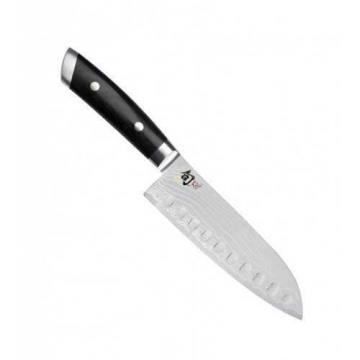
KAI Santoku Knife
Oh, we can say a lot about KAI Santoku knives. The short version: the Santoku knife is the multipurpose knife of Japanese cuisine. With its almost straight blade, it perfectly cuts meat, fish, and vegetables. Hence the name: Santoku means something like knife of three virtues. The wide blade serves as a palette to move the cut material and provides stability. A KAI Santoku knife can be found in every series. Additionally, some series also feature a Santoku knife with a shorter blade, such as the KAI Shun Santoku 14 cm. If you want to learn more: we also have a long version about the KAI Santoku knives available.
The KAI Santoku
The Santoku knife is the quintessential main knife for Japanese chefs. It is used for cutting meat, fish, and vegetables. Thanks to its shape and precise handling, the Santoku has also long impressed European chefs. It is therefore more than logical that KAI Santoku knives are an essential component of every series.
The difference between Santoku and chef's knife
The main knife in European kitchens is the chef's knife, whereas in Japanese kitchens it is the Santoku. The areas of use are identical. With both knives, approximately 80% of all cutting tasks can be accomplished. However, the knives differ in blade shape. In the classic form, the blade of the chef's knife is curved upwards at the tip. The blade of the Santoku is straighter and has only a slight curve at the tip. Also, the blade of a Santoku is wider. Nowadays, however, both knives are made with a similar blade shape, so the difference is usually only reduced to the wider blade of the Santoku.
One or more Santoku knives in almost every series
A knife collection without a Santoku would not be complete. Therefore, you will find one or more Santoku knives in every series.
The KAI Wasabi Black Santoku has an 18 cm long blade with a hardness of +/- 58 HRC made from a special, corrosion-resistant stainless steel. The oval handle made from a combination of plastic and bamboo powder is extremely robust and waterproof.
With a handle made from Redwood wood, the KAI Seki Magoroku Redwood Santoku is equipped. The blade length is 18 cm and is made from Carbon 1K6 stainless steel with a hardness of +/- 58 HRC.










